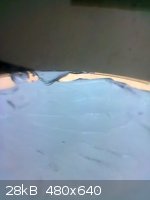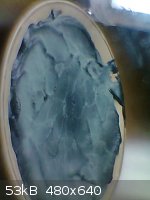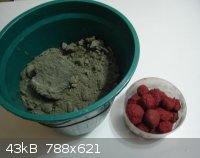| Pages:
1
2 |
rstar
Hazard to Others
  
Posts: 138
Registered: 22-9-2011
Location: Besides valence shell
Member Is Offline
Mood: Dark
|
|
FePO4 blue !?
Hi
I made FeCl2 solution. In another container i dissolved some BAP(biammonium phosphate, that i bought frm fertilizer store) in water and filtered it.
When i added FeCl2 to BAP , i instantly saw white ppt. I believ that it was FePO4. I allowed that to settle down.
After a few hours, i saw that the precipitate now looks bluish. I filtered that and allowed to dry. Now some parts of the ppt look even darker blue.
I'm going to upload a photo of it.
Now my question is, Wth have i made ?
"A tidy laboratory means a lazy chemist "
- Jöns Jacob Berzelius
|
|
|
rstar
Hazard to Others
  
Posts: 138
Registered: 22-9-2011
Location: Besides valence shell
Member Is Offline
Mood: Dark
|
|
Photo, with my low quality camera

"A tidy laboratory means a lazy chemist "
- Jöns Jacob Berzelius
|
|
|
blogfast25
International Hazard
    
Posts: 10562
Registered: 3-2-2008
Location: Neverland
Member Is Offline
Mood: No Mood
|
|
An orthophosphate with a Fe(II) salt could never yield Fe(III)PO4, without prior oxidation of the ferrous ions to ferric ions.
Fertiliser diammonium phosphate is likely to seriously contaminated.
Fe3(PO4)2 does appear to exist though and is reported as insoluble.
[Edited on 15-3-2013 by blogfast25]
|
|
|
AJKOER
Radically Dubious
    
Posts: 3026
Registered: 7-5-2011
Member Is Offline
Mood: No Mood
|
|
Perhaps "Ferrous ammonium phosphate" ?
Pure dry FeNH4PO4 is a greyish-green powder. See http://www.fao.org/ag/agn/jecfa-additives/specs/monograph7/a...
One route to preparation:
"Ferrous ammonium phosphate is manufactured by first combining
iron powder and phosphoric acid in deionized water with stirring
and heating the mixture to get ferrous hydrogen phosphate as a
slurry. Ammonia is added to get ferrous ammonium phosphate."
[EDIT] Your possible reaction:
(NH4)2HPO4 + FeCl2 --> FeNH4PO4 (s) + NH4Cl + HCl
and the presence of HCl limits the hydrolysis of the FeCl2:
FeCl2 + 2 H20 <---> Fe(OH)2 + 2 HCl
[Edited on 15-3-2013 by AJKOER]
|
|
|
blogfast25
International Hazard
    
Posts: 10562
Registered: 3-2-2008
Location: Neverland
Member Is Offline
Mood: No Mood
|
|
Not very likely, IMHO. The dissociation of diammonium phosphate:
(NH4)2HPO4(s) === > NH4(+)(aq) + HPO4(2-)(aq)
The trouble is that there really isn’t anything in there that can the deprotonate HPO4(2-), except for insolubility of FeNH4PO4.
[Edited on 15-3-2013 by blogfast25]
|
|
|
DraconicAcid
International Hazard
    
Posts: 4357
Registered: 1-2-2013
Location: The tiniest college campus ever....
Member Is Offline
Mood: Semi-victorious.
|
|
If FeNH4PO4 is sufficiently insoluble, then
Fe2+ + NH4+ + 2 HPO42- --> FeNH4PO4(s) +
H2PO4-
will be favourable.
Anyone know the Ksp of FeNH4PO4?
If we use K2 = 7e-8 and K3 = 4e-13 for phosphoric acid, then the disproportionation reaction would have a Keq of 5.7e-6. So if the Ksp for
FeNH4PO4 is 6e-6 or less (and most Ksp values are), then this reaction will have a Keq of greater than one.
[Edited on 15-3-2013 by DraconicAcid]
[Edited on 15-3-2013 by DraconicAcid]
Please remember: "Filtrate" is not a verb.
Write up your lab reports the way your instructor wants them, not the way your ex-instructor wants them.
|
|
|
rstar
Hazard to Others
  
Posts: 138
Registered: 22-9-2011
Location: Besides valence shell
Member Is Offline
Mood: Dark
|
|
That means my BAP is contaminted and i made an iron complex. But what kind of iron complex could have bluish color ?
"A tidy laboratory means a lazy chemist "
- Jöns Jacob Berzelius
|
|
|
rstar
Hazard to Others
  
Posts: 138
Registered: 22-9-2011
Location: Besides valence shell
Member Is Offline
Mood: Dark
|
|
That thing now looks greyish black. Here's a photo

"A tidy laboratory means a lazy chemist "
- Jöns Jacob Berzelius
|
|
|
DraconicAcid
International Hazard
    
Posts: 4357
Registered: 1-2-2013
Location: The tiniest college campus ever....
Member Is Offline
Mood: Semi-victorious.
|
|
I would assume that your wet precipitate is oxidizing, and you're getting a mixed iron oxide/phosphate.
Please remember: "Filtrate" is not a verb.
Write up your lab reports the way your instructor wants them, not the way your ex-instructor wants them.
|
|
|
AJKOER
Radically Dubious
    
Posts: 3026
Registered: 7-5-2011
Member Is Offline
Mood: No Mood
|
|
OK, some related research (see bottom of page 11 at http://click.infospace.com/ClickHandler.ashx?du=http%3a%2f%2... ). To quote:
≡FeOH0 + PO43- + 3H+ ↔ ≡FeH2PO4 + H2O log K1 = 32.08 (1)
≡FeOH0 + PO43- + 2H+ ↔ ≡FeHPO4- + H2O log K2 = 26.39 (2)
≡FeOH0 + PO43- + H+ ↔ ≡FePO42- + H2O log K3 = 20.73 (3)
12
How much ferric is needed to remove phosphorus?
Traditionally the ferricphosphate precipitant FePO4(s) was thought to be the primary precipitant in wastewater treatment. However, recent research
(Smith et al., 2008) showed a complex structure, with several fundamental reactions occurring simultaneously as iron reacts to form ferric hydroxides
and phosphates.
The amount of phosphate that binds to the metal hydroxide is still a topic of discussion. Current research suggest that the stoichiometric ratio of
metal:phosphorus (Me: P) in the precipitant depends on many factors, including the phosphate concentration in the liquid, chemical dose, age of the
hydroxyl complex, mixing, and many other factors (Szabo et al., 2008, de Haas et al., 2000, Yang et al., 2006)."
Now, this somewhat current (2008) 'topic of discussion' among researchers is before anyone has introduce NH4+. With respect to the precise chemistry
involved in the cited procedure, I am even more indefinite without addressing impurities.
|
|
|
blogfast25
International Hazard
    
Posts: 10562
Registered: 3-2-2008
Location: Neverland
Member Is Offline
Mood: No Mood
|
|
I doubt strongly that the conditions decribed in that infospace paper can apply to what 'rstar' was doing.
These 'FeOH values' for instance are for surface reactions on hydrated ferric oxide. Not greatly relevant here, IMHO...
'rstar' should repeat his experiment using stoichiometric amounts of reagents and assuming FeNH4PO4 is formed. Then see what colour he gets.
Assuming FeNH4PO4 was precipitated and that there was an excess Fe(II) available, the latter would have started to oxidise to Fe(III). Having Fe in
two different oxidation states could possibly lead to strange results (see e.g. magnetite and Berlin Blue).
[Edited on 16-3-2013 by blogfast25]
|
|
|
rstar
Hazard to Others
  
Posts: 138
Registered: 22-9-2011
Location: Besides valence shell
Member Is Offline
Mood: Dark
|
|
Hey ! now the colour actually looks greyish-green
"A tidy laboratory means a lazy chemist "
- Jöns Jacob Berzelius
|
|
|
blogfast25
International Hazard
    
Posts: 10562
Registered: 3-2-2008
Location: Neverland
Member Is Offline
Mood: No Mood
|
|
You mean the blue has now changed colour to greyish-green? Did any drying take place?
|
|
|
rstar
Hazard to Others
  
Posts: 138
Registered: 22-9-2011
Location: Besides valence shell
Member Is Offline
Mood: Dark
|
|
Oh yes...
There was drying...
I guess it may be a Fe - NH4 complex. 
"A tidy laboratory means a lazy chemist "
- Jöns Jacob Berzelius
|
|
|
DraconicAcid
International Hazard
    
Posts: 4357
Registered: 1-2-2013
Location: The tiniest college campus ever....
Member Is Offline
Mood: Semi-victorious.
|
|
Can't be. Ammonia can form complexes with transition metals because it has a lone pair it can donate to the metal. The ammonium ion doesn't have a
lone pair, and can't act as a Lewis base (i.e., a ligand).
Please remember: "Filtrate" is not a verb.
Write up your lab reports the way your instructor wants them, not the way your ex-instructor wants them.
|
|
|
ElectroWin
Hazard to Others
  
Posts: 224
Registered: 5-3-2011
Member Is Offline
Mood: No Mood
|
|
any chance there is a bit of copper in that fertilizer?
|
|
|
rstar
Hazard to Others
  
Posts: 138
Registered: 22-9-2011
Location: Besides valence shell
Member Is Offline
Mood: Dark
|
|
What if this is FeNH4PO4, that also looks greenish, right?
is there any test for it ?
"A tidy laboratory means a lazy chemist "
- Jöns Jacob Berzelius
|
|
|
blogfast25
International Hazard
    
Posts: 10562
Registered: 3-2-2008
Location: Neverland
Member Is Offline
Mood: No Mood
|
|
It should dissolve in concentrated sulphuric acid, displacing the weaker phosphoric acid, into a greenish solution of FeSO4 and (NH4)2SO4. But that's
not a definitive test...
|
|
|
rstar
Hazard to Others
  
Posts: 138
Registered: 22-9-2011
Location: Besides valence shell
Member Is Offline
Mood: Dark
|
|
I havnt stored it in a vessel yet, it's outside in the watch glass. Does it react with O2 in air ?
"A tidy laboratory means a lazy chemist "
- Jöns Jacob Berzelius
|
|
|
blogfast25
International Hazard
    
Posts: 10562
Registered: 3-2-2008
Location: Neverland
Member Is Offline
Mood: No Mood
|
|
If it is an Fe(II) salt it probably will oxidise to Fe(III), especially when wet. But that oxidation is compound dependent: Mohr's Salt
[(NH4)2Fe(SO4)2 hydrate] for instance keeps well without oxidation, in dry conditions.
|
|
|
platedish29
Hazard to Self
 
Posts: 76
Registered: 2-9-2012
Member Is Offline
Mood: absorbing CO2
|
|
Okay I got very "pure" mohr salt here, gonna try and mix it down with phosphoric and see what happens, reporting soon with a edit,.
EDIT: the precipitation of iron II out of mohr's salt takes a little while, so I'll refer to see photo that might be of interest: it is a sample from
a local excavation which florished this amazing red clay which I believe is composed of iron, along this other green stuff inside the bigger bucket
which I believed could be chromium but I'm more inclined for it be green rust. It came in larger chunks that were smashed into a powder!
(current reproduction of the original experiment coming..)
EDIT 2: yea ammonium iron phosphate is really grey-green. But when it was first prepared starting through iron hydroxide, thats green in color, and
phosphoric acid, it first dissolved completely and turn red-brown? Then uppon addition of ammonium hydroxide it turned to the final color.
I think its just hydration, no big enigma.
Perhaps a roast should do for it to turn white?

[Edited on 19-3-2013 by platedish29]
|
|
|
blogfast25
International Hazard
    
Posts: 10562
Registered: 3-2-2008
Location: Neverland
Member Is Offline
Mood: No Mood
|
|
Quote: Originally posted by platedish29  | EDIT 2: yea ammonium iron phosphate is really grey-green. But when it was first prepared starting through iron hydroxide, thats green in color, and
phosphoric acid, it first dissolved completely and turn red-brown? Then uppon addition of ammonium hydroxide it turned to the final color.
[Edited on 19-3-2013 by platedish29] |
Take us through what you did precisely?
|
|
|
elementcollector1
International Hazard
    
Posts: 2684
Registered: 28-12-2011
Location: The Known Universe
Member Is Offline
Mood: Molten
|
|
Iron(II) hydroxide is green in color... until it meets atmospheric oxygen. Then it turns to rust-brown Fe(OH)3.
Elements Collected:52/87
Latest Acquired: Cl
Next in Line: Nd
|
|
|
rstar
Hazard to Others
  
Posts: 138
Registered: 22-9-2011
Location: Besides valence shell
Member Is Offline
Mood: Dark
|
|
Ok, when i scrapped off that stuff from my watchglass, i saw that it was the same ol' bluish color (seen in the first image) . I stored it in a amber
coloured glass vessel. I don't think i will need it so i'm gonna discard it shortly 
Well, i wanna make some FeCl3, can anyone tell me a fast method of oxidizing FeCl2, without the use of H2O2 or Cl2 ?
"A tidy laboratory means a lazy chemist "
- Jöns Jacob Berzelius
|
|
|
blogfast25
International Hazard
    
Posts: 10562
Registered: 3-2-2008
Location: Neverland
Member Is Offline
Mood: No Mood
|
|
Quote: Originally posted by rstar  |
Well, i wanna make some FeCl3, can anyone tell me a fast method of oxidizing FeCl2, without the use of H2O2 or Cl2 ? |
There are plenty of oxidisers that will oxidise Fe(II) to Fe(III) but few leave no trace. Then you need to separate the oxidiser by-product (its
reduced form) from the desired FeCl3. Not easy. That's why Cl2 and H2O2 are the most desirable. H2O2 is also cheap as chips and readily available.
Air will do it too but it's a bit of a slow boat to China for practical, 100 % conversions.
HNO3 also does it but NO/NO2 (and water) is released, so be careful. And for most, HNO3 is not OTC or easily available...
[Edited on 19-3-2013 by blogfast25]
|
|
|
| Pages:
1
2 |